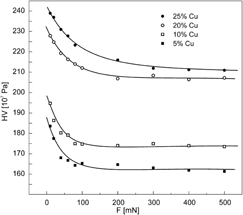Article contents
Instrumented indentation testing of arsenic triselenide–arsenic triiodide pseudobinary glasses with copper
Published online by Cambridge University Press: 17 October 2012
Abstract

In this research, we performed experimental investigations of the influence of copper presence on hardness of arsenic triselenide (As2Se3)–arsenic triiodide (AsI3) pseudobinary glasses. The samples belong to the group of chalcogenide glasses, that, when compared with oxide glasses, can be synthesized much more easily in a wide variety of compositions, allowing also fine-tuning of their properties. Here, presence of iodine (I) facilitates glass formation, whereas addition of copper (Cu) creates possibility for interesting optoelectronic properties. As it is important to study mechanical properties of materials with respect to their fabrication and manipulation, we report results of instrumented indentation testing (IIT) of bulk samples of Cux[(As2Se3)0.9(AsI3)0.1]100−x with x = 5, 10, 20, and 25 at.% of Cu. This technique enables fast determination of indentation hardness, hardness value according to Vickers and indentation modulus directly from the indentation load–displacement curves. It was shown that all these parameters increase linearly with the increase of copper content. Improvement of the mechanical properties justifies the addition of Cu into the glass matrix.
- Type
- Articles
- Information
- Copyright
- Copyright © Materials Research Society 2012
References
REFERENCES
- 2
- Cited by


